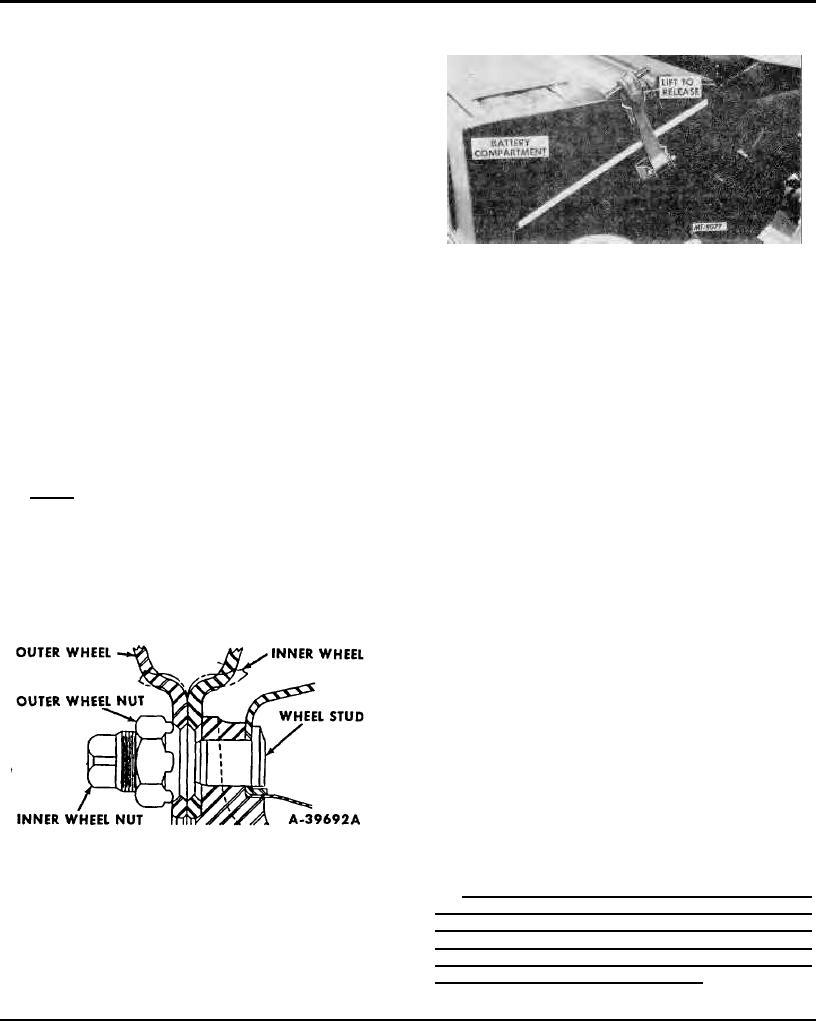
BATTERY
MAINTENANCE
camber, and axle caster.
WHEEL AND RIM MOUNTING NUTS
Disc Wheels
1. Mounting faces of the hub, wheel, and nut must
be free from dirt or excess paint. Mounting faces which
have been damaged from wear or abuse must be
repaired or replaced.
2. Right hand threads are used on the right side of
the vehicle and left hand threads on the left side.
Keep the batteries fully charged and check the
solution level at least every 15 days during hot weather
and 30 days in cold weather.
3. Tighten the wheel nuts alternately.
The solution in each cell should be 3/8" above the
4. Tighten the single wheel mounting stud nuts to
separator plates, or to the indicator level. When the
450-500 foot pounds torque.
solution is below this level, add distilled water, using a
clean syringe. Acid or electrolyte should never be added
5. On dual wheels loosen the outer nuts before
except by skilled battery personnel.
attempting to tighten the inner nuts. Tighten inner nuts
to 500 feet pounds torque and outer nuts to 450 foot
Under no circumstances should any special battery
pounds torque.
"dopes", solution, or powders be added to batteries.
NOTE: Always tighten the inner nuts 50 foot
Test the specific gravity of the electrolyte in each cell
pounds more than the outer nuts and never let the
with a hydrometer at least once a month. A hydrometer
outer nuts get below 400 foot pounds.
reading of 1.260 at 80 degrees F. indicates a full
charge. Never allow the battery to fall below 1.225
It is good practice to repeatedly (daily) tighten the
which indicates half charged. A discharged battery will
wheel nuts during the first 500 miles of service on new
freeze at 20 degrees F. above zero. A fully charged
trucks and any time the wheels have been removed.
battery will withstand temperatures as low as 80 degrees
Regular inspection periods should be established to
F. below zero.
assure keeping the nuts tight.
Battery cable terminals must be clean and tight.
Use hot water and common baking soda for removing
terminal corrosion and for cleaning the top of the battery.
Brighten the contact surface with steel wool, apply a light
coat of vaseline or chassis lubricant, and reassemble.
Be sure the terminals are clamped tightly and that the
battery is clamped securely in the battery box.
When working around the terminals and batteries
use extra care to avoid shorting. A good practice is to
insulate pliers and screwdrivers used with this system.
DO NOT CHECK BATTERY CONDITION BY
SHORTING (FLASHING) ACROSS TERMINALS.
CAUTION: Hydrogen gas is produced in the
normal operation of the battery.
Therefore, to
prevent a fire or dangerous explosion, it is
imperative that flames or sparks (that could be
caused by the use of jumper cables) be kept away
from the vent openings of the battery.
25

